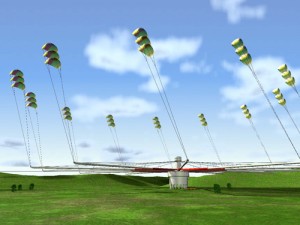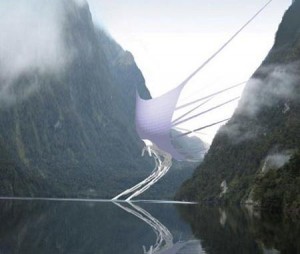Real Kite Power!

If anyone has been pulled along by a kite as a child, they will have had firsthand experience of the true power of the wind. Therefore, it make perfect sense for us to use this perfect tool for capturing the wind’s energy and use it to power our homes or to run our cars.
Some experts estimate that the total energy contained in wind is 100 times the amount needed by everyone on the planet. However, most of this energy is at high altitude, far beyond the reaches of any wind turbine.
So it’s little wonder that researchers across the world have been working on generating electrical power from kites that can catch these high winds
Source: It’s a kite…but not as we know it
In Italy, the Kite Wind Generator, or KitGen for short, use kites that spring from funnels on the end of giant poles when the wind blows. For each kite, winches release a pair of high-resistance cables to control direction and angle. The kites are similar to those used for kite surfing – light and ultra-resistant, capable of reaching an altitude of 2,000 meters.
http://www.wired.com/news/images/full/kitegen1_f.jpg
The swirling kites set KitGen’s core in motion, and the rotation activates large alternators producing a current. A control system on autopilot optimizes the flight pattern to maximize the power produced as it sails on night and day. An advanced radar system can redirect kites within seconds in case of any interference, such as birds.
The technology costs a modest US$750,000 and takes up a limited amount of space but even with a diameter of just 100 meters, they estimate KiteGen can produce half a GW of energy, and produce energy at a cost of US$2.5 per GW. Its creators, Sequoia Automation, say a 2,000 meter-version would generate 5GW of power.
KitGen’s website claim that the “innovative concept that may be the most practical and sound solution, in the market of renewable sources, to the world’s energy needs and problems.” Let’s hope so.
Giant Kites
Once again in Europe, scientists from the Delft University of Technology in the Netherlands have harnessed energy from the wind using similar technology to KitGen by flying a 10-sq metre kite tethered to a generator, producing 10 kilowatts of power.
The experiment, carried out last year, generated enough electricity to power 10 family homes, and the researchers have plans to test a 50kW version of their invention, called Laddermill, eventually building up to a proposed version with multiple kites that they claim could generate 100 megawatts, enough for 100,000 homes.
Kites are seen as the perfect and cheapest way to capture the enormous energy in the wind at a kilometre or more above the ground, where winds carry hundreds of times more energy than on the ground.
These giant kites generate power by pulling on a string attached to generators on the ground. When it has reached its maximum height, it is reeled back down to repeat the process.
This technology has stirred some of the world’s giants. Google.org, the philanthropic environment-loving arm of the Californian web-search company, invested $10 million in 2007 in a US kite company called Makani, one of the first awards as part of the organisation’s Renewable Energy Cheaper than Coal programme.
The Wind Dam

British architect Laurie Chetwood has come up with a pretty insane take on a yacht’s sail. Chetwood has publicly criticised wind turbines, arguing that far more wind passes around a turbine than through its rotors.
His solution was to significantly increase efficiency by capturing high-speed winds with a massive spinnaker sail-like those that yachts deploy to gain more speed.
wind-energy.jpg
The conical shape of the sail directs air to three in-line turbines, which are enclosed in a tube. The wind spins each turbine’s blades and turns an axle that runs into its gearbox. The gearbox steps up the rotational speed of a shaft that spins magnets around a wire inside the generator to transform the movement into electricity through electromagnetic induction.
A modest amount of electricity, but the idea has the potential to be developed.
But it has also received plenty of criticism, far more than other renewable energy ideas involving kites. Most worrying for Chetwood is the criticism received from Stephen Connors, a wind-energy expert at the Massachusetts Institute of Technology (MIT) Energy Initiative, who doesn’t think the dam could stand up to winds gusting in multiple directions, and that turbulence would mean it would struggle to concentrate wind on the turbine.
Construction was meant to have started over a year ago, but the project has hit a number of snags and its cost, initially places at around $4 million, remains under scrutiny.
Wind is one of our most valuable resources
One has to admire the idea of taking the humble kite and turning it into tool that can harness the most powerful winds that not even the world’s largest wind turbine could ever reach.
Wind is one of mankind’s most valuable, powerful and plentiful resources and it is relatively cheap to capture in comparison to the high tech solar panels that catch the sun’s rays.The beauty of using kites is that they’re uses stretch beyond merely rotating a generator, they could even be used to haul ocean vessels across the ocean, massively reducing the carbon footprint of the sea freight industry – one of the most polluting in the world.
Kites could quickly become one of the largest contributors to fighting climate change. And they’re also pretty good fun.

Leave a Reply
Want to join the discussion?Feel free to contribute!